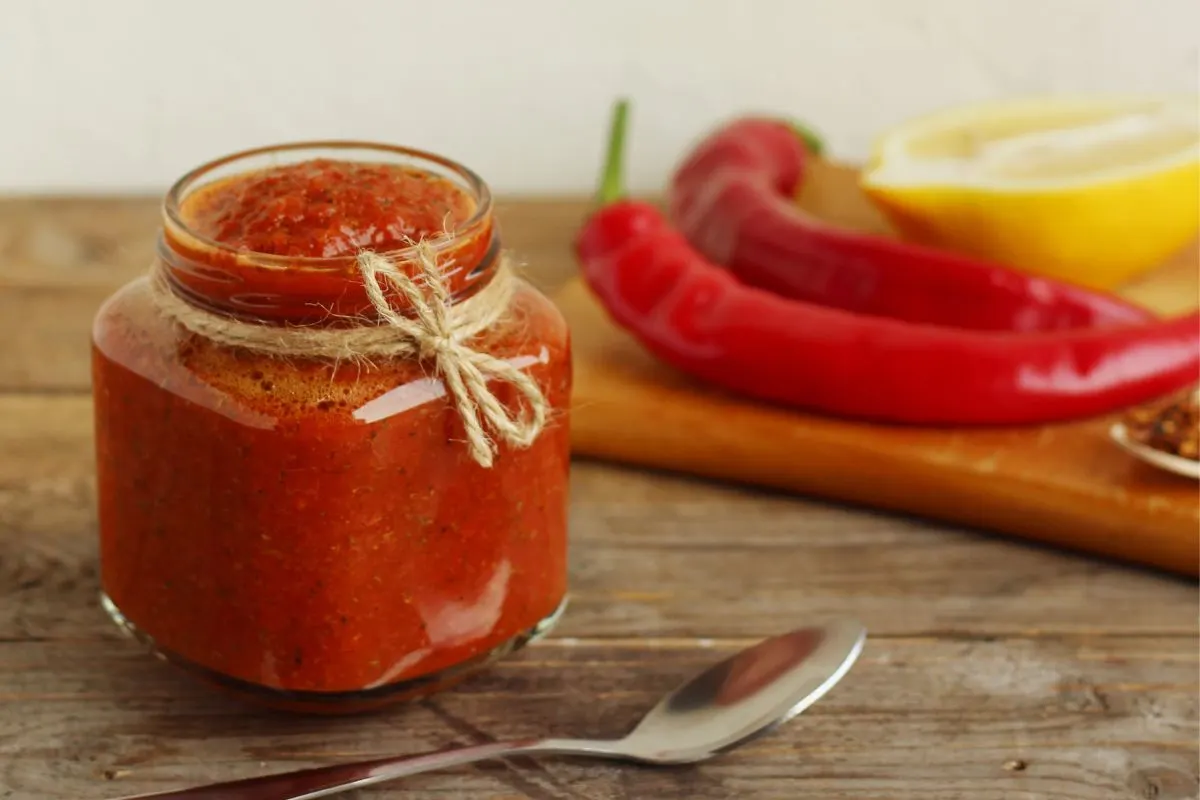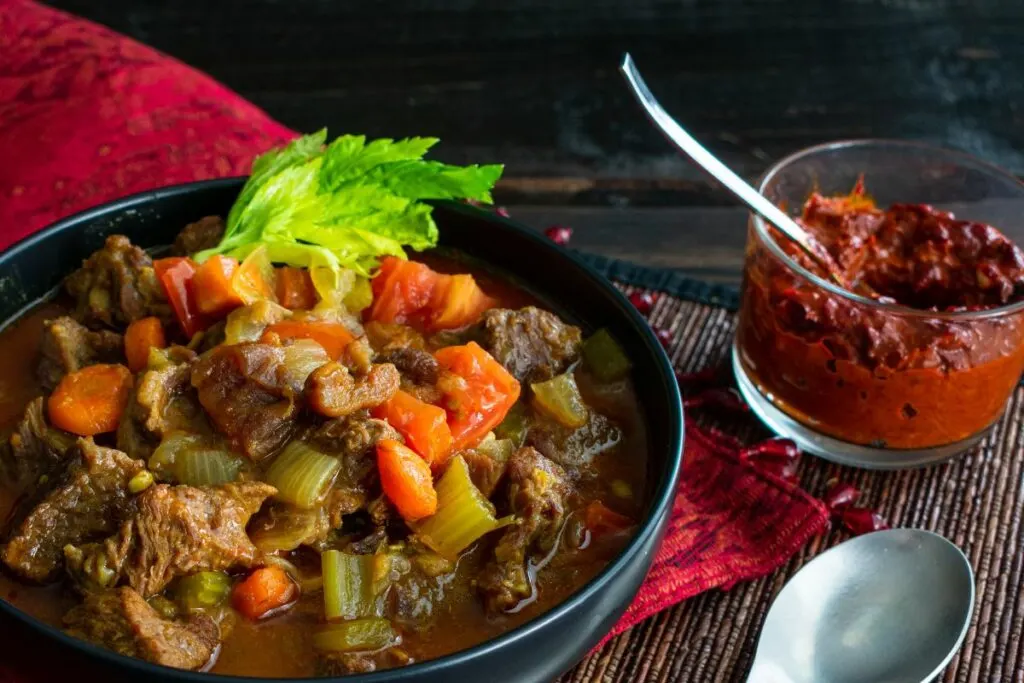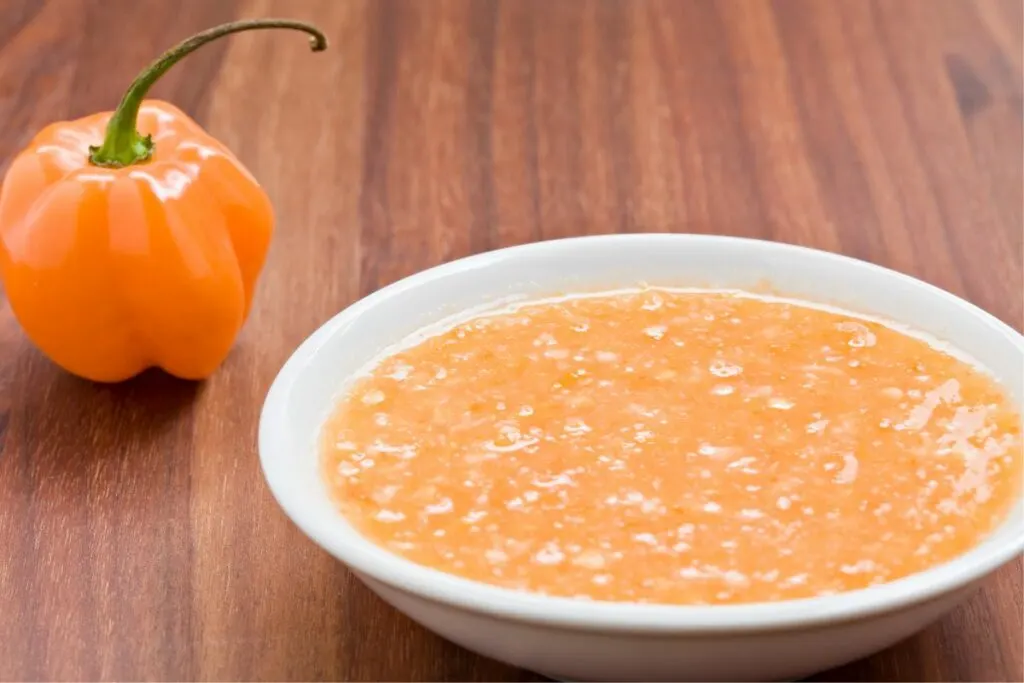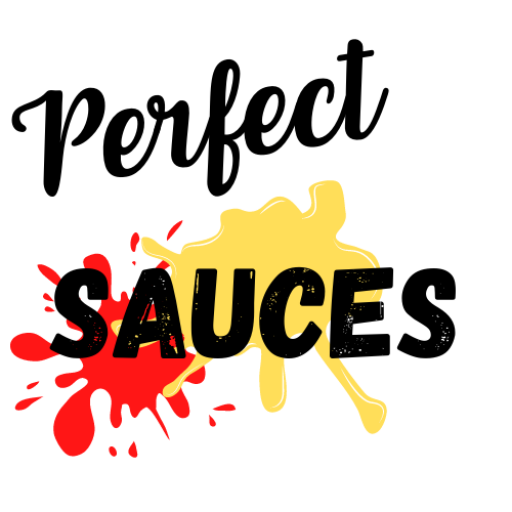Dreaming of that grilled harissa shrimp from your fave Moroccan hole-in-the-wall but don’t have one of the tastiest Asian sauces on hand? Well, you can easily recreate that fiery chili shrimp dish with a harissa substitute! Some of these harissa substitutes include hot sauce, gochujang (Korean red chili paste), or sambal oelek. But these aren’t the only substitutes for harissa, as you’ll soon find out! Let’s jump in!

Jump To
🤷 What is Harissa?
This flavorful chili paste is from North Africa’s Maghreb region and mostly made up of roasted red peppers, chili peppers, and spices like saffron, garlic, cumin, and coriander seeds, all brought together into a paste by olive oil. The chili peppers frequently used are roasted red bell peppers, smoked serrano’s, and baklouti peppers, but feel free to use any roasted peppers of any variety or dried chili peppers (chiles de arbol, ancho peppers, guajillo peppers, and pasilla peppers).
🧑🍳 How to Make Harissa
To make harissa paste, blend together hot chili peppers (such as cayenne or serrano), garlic cloves, smoked paprika, ground cumin, coriander, caraway seeds, a pinch of salt, and olive oil in a food processor until a smooth paste is formed. You can use some paprika substitutes if you don’t have any around. If you wanna make it spreadable, the mixture is traditionally blended with olive oil which aids in building flavor.
📌 How to Use Harissa Sauce
Harissa is a fantastic ingredient to include in your dishes because it comes with several perks for your health. Here are several recipes where the vibrant pungent fiery flavors of Harissa shines and really elevates dishes.
- Harissa Shrimp Fra Diavolo
- Moroccan chicken and Chickpea Stew
- Pumpkin and Coconut Cream soup with Harissa creme fraiche
- Harissa marinated steaks
- Hummus with a dollop of Harissa paste
- Halibut rubbed with Harissa butter
- Harissa Meatballs
- Meatballs with tomato harissa gravy
- Angus Beef burger with Harissa aioli
- Creamy game day dip fueled with Harissa for crudites or potato wedges

💡 7 Best Harissa Sauce Substitutes
DIY Harissa
Any red or green chili pepper you have on hand will work to make homemade harissa paste. To make it, just pulse the peppers (fresh or dried— in a food processor with olive oil, raw garlic, salt, cumin, coriander, and caraway seeds until a paste forms. Process the fresh peppers in a food processor before proceeding if you’re using fresh ones. If you’re using dried peppers, rehydrate them in boiling water for roughly 20 minutes. When soft, combine it with the remaining ingredients and pulse them in a food processor.
Chili Paste
Two of the most popular chili pastes in the Asian scene are sambal oelek and shrimp paste. Sambal oelek is one of our favorite hot pepper pastes. You can get this chili paste from an Asian market, but you can use sambal oelek substitutes if you can’t find any. It’s a fantastic alternative to harissa, containing chili peppers, garlic, and lime juice, which mimic its flavors. Even though the shrimp paste in sambal oelek creates a fishy, you can still use an equal 1:1 ratio for every tablespoon of sambal oelek (a 1:1 ratio).

Gochujang
Gochujang is produced from glutinous rice, red chili peppers, and fermented soybeans. A perfect alternative to harissa paste. It offers a comparable level of heat and texture but with a more noticeable tang. Expect the flavors to vary a bit from harissa due to the diverse ingredients. But it still functions well when substituting harissa as a base for dipping sauces or a marinade for meat or vegetables. If you don’t have gochujang, you can use a gochujang substitute. Just make sure to keep a similar 1:1 ratio.
Berbere + Chili Powder
Berbere is a tasty blend of aromatic spices. In addition to the Middle Eastern spices found in harissa paste, like coriander, garlic, cumin, and ground chilies, this unique mixture also contains paprika, cardamom, fenugreek, and other spices. Although the overall flavor is not as hot as harissa paste, it still has a peppery, sweet, and citrus flavor that adds a lot of spice to dishes. Substitute ¾ tablespoon of berbere spice mix + ¼ tablespoon of chili powder for each tablespoon of harissa that a recipe calls for.
Tabil
To mimic the flavors of harissa in soups or stews, use a Tunisian and Algerian spice blend called tabil. Tabil’s prominent flavor notes are closely related to harissa paste’s seasonings and spices. However, there are additional ingredients in this spice mix, like carraway, clove, turmeric, black peppercorn, and fennel, which may alter the taste of your dish differently. When using tabil as a harissa paste substitute, use ¾ tablespoon of tabil with ¼ tablespoon of chili powder. Blend the spices with a bit of oil if the oil in harissa is needed in your dish.

Hot Sauce
When a recipe calls for harissa, you usually just want some heat. In this case, Tabasco, Sriracha, Louisiana hot sauce, hot pepper sauce, cayenne pepper sauce, habanero sauce, or diablo sauce are all good options. Because harissa paste has a thick viscosity, you’ll need to know how to thicken hot sauce for a more equal consistency. You can always thicken sauce without cornstarch or flour, but make sure what you use matches instead.
Tomato Paste + Chili Powder
Tomato paste with a dash of chili powder can be one of the best substitutes for harissa. It’s deliciously thick and flavorful, and while you won’t get the same exact flavor, you will get the same consistency. We recommend combining the tomato paste with a few dashes of hot sauce or a teaspoon of chili powder if you’re missing the heat. You can use some chili powder substitutes if you want spicier or milder options. Use at a 1:1 ratio when mixing either. For a sweeter version, swap the tomato paste for some plum sauce alternatives.
🧐 FAQs
If you’re looking for a milder alternative to harissa paste, try using smoked paprika, chili powder, or a combination of the two. These spices will give your dish a similar smoky flavor without the intense heat of harissa.
Some of the most popular substitutes include sambal oelek, hot sauce, sriracha, red chili paste, and chili oil. These options will give your dish a similar level of heat and flavor as harissa paste.
While tomato paste can add a similar depth of flavor to your dish as harissa paste, it won’t provide the same heat level, so no. If you’re looking for a spicy alternative to harissa paste, try one of the other substitutes listed above.
The paste is highly aromatic and has a deeply earthy flavor that’s rich and spicy. Depending on the peppers and spices used, the flavors are intensely aromatic with a hint of more sweetness or tang.
